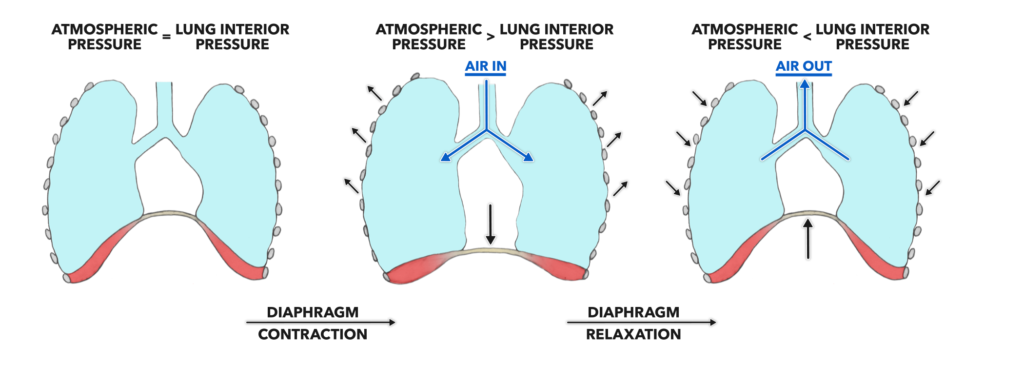Breathing. We all do it without thinking. Our chests rise and fall while we’re awake, asleep, and doing everything else in between birth and death. But when we are knee deep in a WOD, we really start thinking about our next breath. That movement of air in and out is, in part, what keeps us going.
The mechanics of ventilation, moving air from the atmosphere into and then out of the lungs, is a fairly simple process. Our anatomy is cleverly designed to create negative pressure (a vacuum) within the thoracic cavity. This draws air in and then creates positive pressure to push air out.

Diaphragmatic contraction and rib cage expansion increases lung volume, reduces intra-lung pressure, and draws air into the lungs. Relaxation produces the opposite effects and expels air from the lungs.
From their location within the rib cage, the lungs are affected by many thoracic muscles, a few cervical muscles, some abdominal muscles, and most importantly, the diaphragm.
When we inhale, the diaphragm contracts, pulling the floor of the thoracic cavity downward. By pushing the underlying abdominal anatomy down and forward (lie down and watch your belly when you breathe normally) and by virtue of the fluid seal provided by the pleura, a negative pressure, one lower than that in the environment around you, is created. Gases will move from an area of high pressure to one of low pressure, so air enters the lungs via the airway.
Lung size varies with body size, but an average pair of lungs has about 5.1 liters (1.35 gallons), and not all of that volume is used all the time. At the end of a relaxed exhalation, average-sized lungs contain about 2.1 liters of air. The lungs are never empty. After a normal inhalation, they contain about 2.6 liters of air, which means our average breath cycle moves 0.5 liters into and out of the lungs.
That volume, that of a normal breath, is called tidal volume. A lung filled to voluntary maximal capacity contains about 4.0 liters of air. This volume is reached only when you actively attempt to fill your lungs as full as possible through a process known as forced inspiration (or vital capacity). When we start exercising harder and harder, the volume of air moving into and out of the lungs with each breath (tidal volume) rises higher and higher toward the full 4.0-liter vital capacity.
Muscles of Normal Ventilation
Diaphragm – Pulls the central tendon and thoracic floor down to induce inhalation. Relaxes to drive exhalation.
External intercostals – Elevate ribs up and out to aid in inhalation. Relax to aid in exhalation.
Scaleni – Elevate ribs up and out to aid in inhalation. Relax to aid in exhalation.
Additional Muscles of Forced Respiration
Sternocleidomastoid – Elevates shoulders to aid in further inhalation.
Serratus anterior – Elevates shoulders to aid in further inhalation.
Rectus abdominis – Compresses the abdominal cavity and pushes the organs and viscera upward to aid in evacuation of air from the lungs.
Transversus abdominis – Compresses the abdominal cavity and pushes the organs and viscera upward to aid in evacuation of air from the lungs.
External oblique – Compresses the abdominal cavity and pushes the organs and viscera upward to aid in evacuation of air from the lungs.
Internal intercostals – Pull ribs down, compressing the thoracic cavity, and adding to exhalation volume.
NOTE: There are over a dozen other muscles that have very small magnitude but similar effects as those major contributors above.
Lung size and breath volume are not the only factors that support life functions at rest and work. Breath rate is also crucial. Our bodies love to be in homeostasis, so the volume and frequency of our breaths are intimately matched to our metabolic status. When we are just sitting around, our breath rate will be about 12 to 16 breaths per minute. This breath rate provides all the needed gas exchange our body needs under those circumstances. If we start walking, metabolic demand goes up slightly, and the body increases breath rate by a couple of additional breaths per minute. Homeostasis between metabolic demand and supply is maintained. An eight-minute mile may drive respiratory rate up to 30 to 40 breaths per minute — again, demand and supply are matched. If we go all in on a WOD and do it unbroken, it is likely that respiratory rate will reach and exceed 50 breaths per minute. An unbroken session means that ventilatory supply is meeting metabolic demand.
But as every CrossFitter has experienced the inability to do some WOD or some metabolic conditioning part of a WOD unbroken, the feeling of respiratory mismatch and the accompanying generalized discomfort is well known. The bottom line is ventilation. Our rate of moving air in and out has an upper limit and is only part of the supply equation. We have to consider what happens at the alveoli to get a more complete picture.
Related Reading